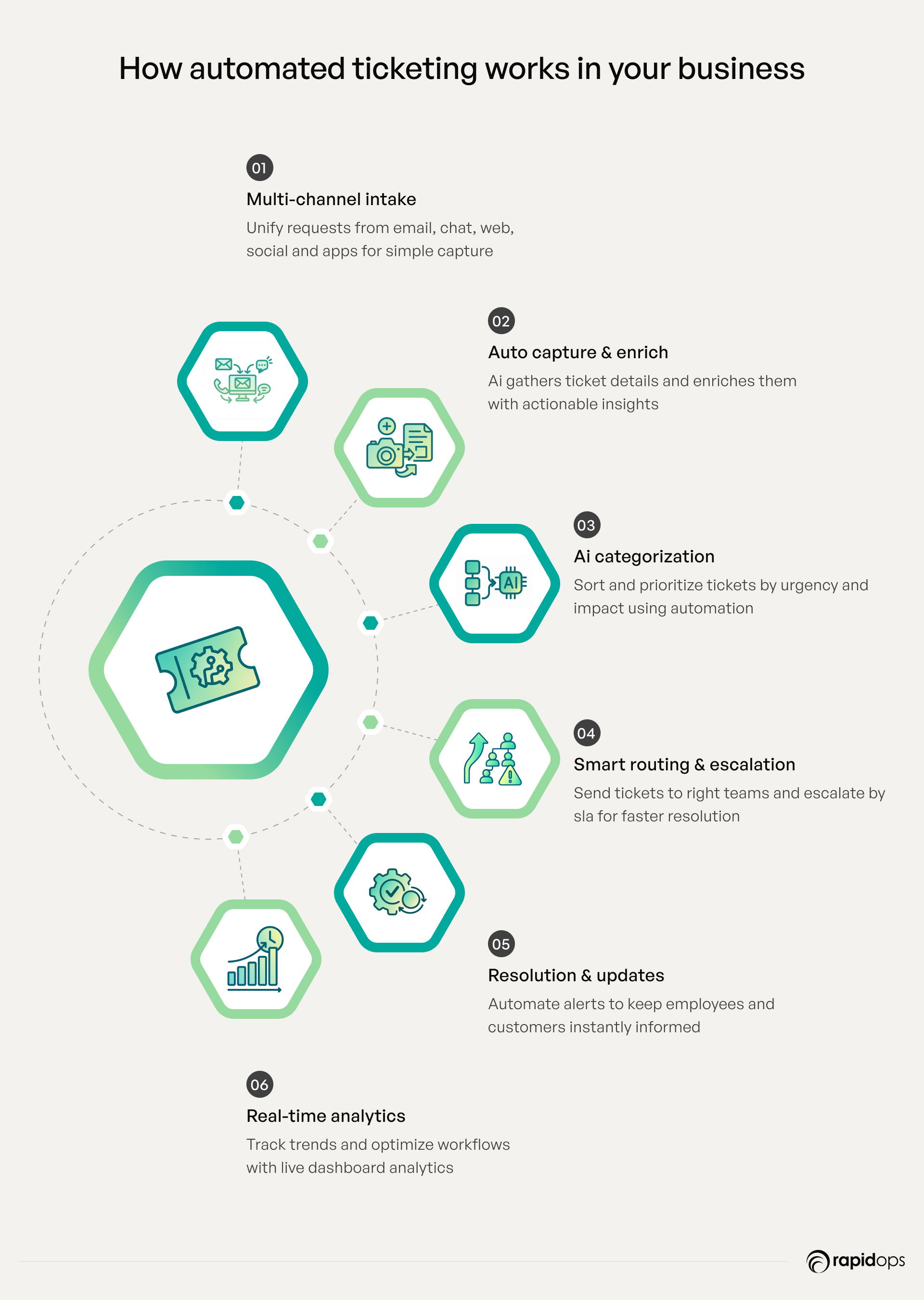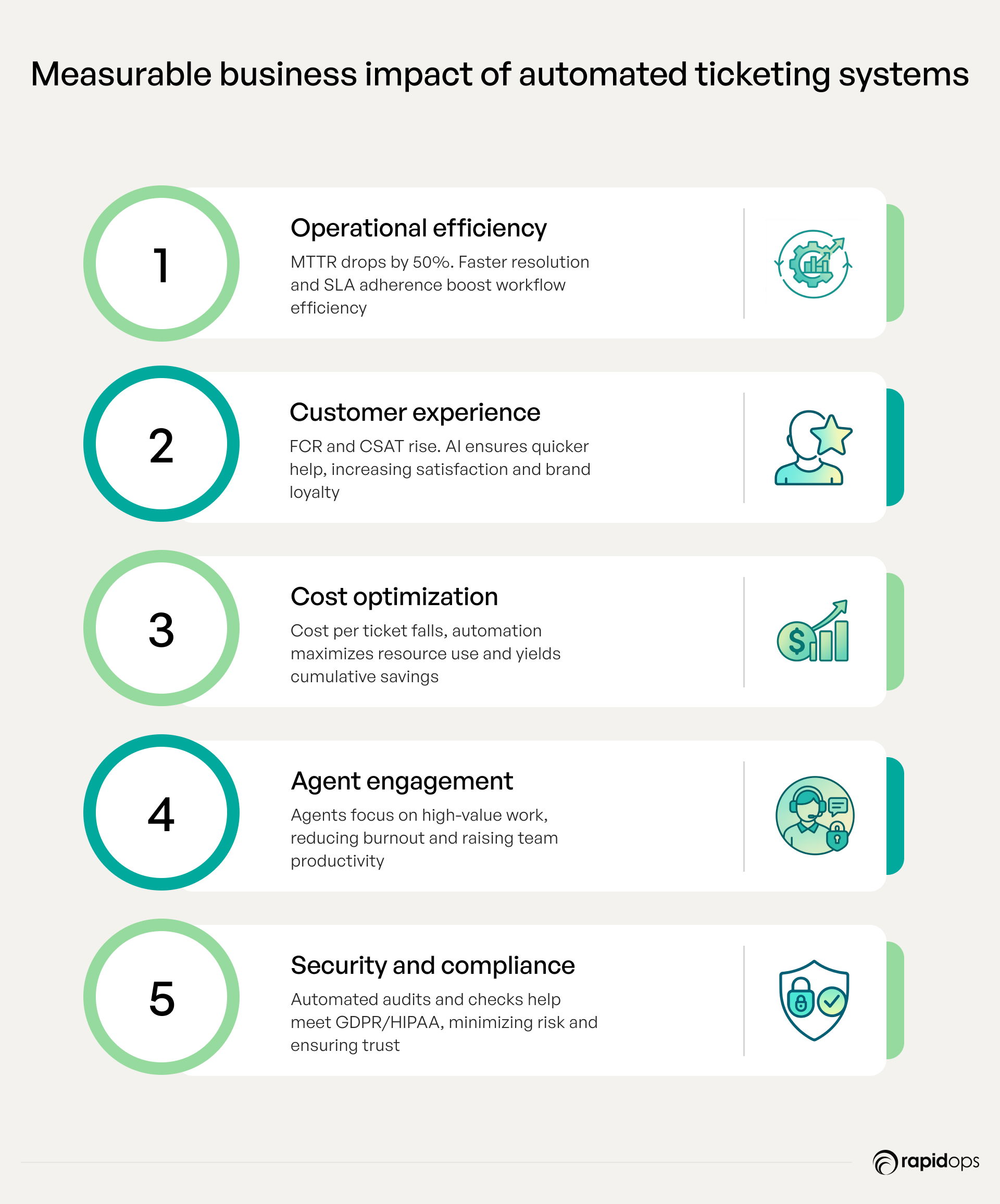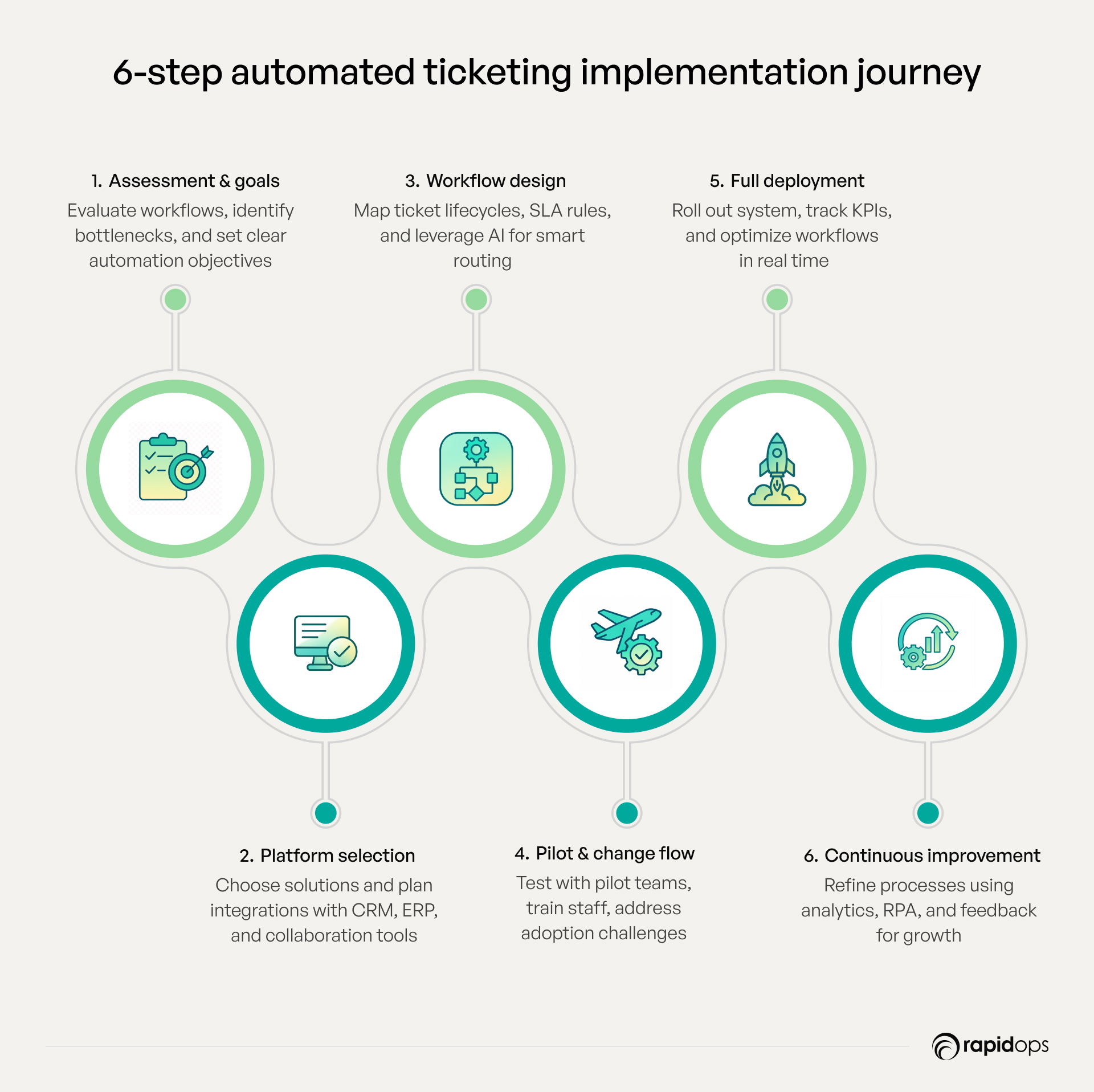Did you know that 80% of customers have switched brands due to poor customer experience? New research from Qualtrics and ServiceNow reveals that unresolved issues and slow resolution times can have a significant impact on customer loyalty. In many organizations, reality looks very different: a customer complaint can sit unresolved for six days, an internal IT request can stall a department for a week, and a client’s follow-up may go unanswered. Individually, these delays seem minor, but together they erode productivity, inflate costs, frustrate employees, and test customer trust.
To bridge this gap, AI-powered automated ticketing steps in. It intelligently creates, categorizes, routes, and prioritizes tickets, turning bottlenecks into clarity and missed SLAs into confidence. Leaders gain real-time oversight, teams gain efficiency, and customers experience faster, more reliable support.
The result is faster, more reliable support and measurable efficiency gains. Automated ticketing reduces resolution times, minimizes ticket backlog, cuts operational overhead, and ensures employees spend less time on repetitive tasks. Customers receive timely responses, teams work more efficiently, and leaders gain real-time visibility into support performance.
In this blog, we explore the benefits, ROI, key KPIs, implementation strategies, and AI innovations that are transforming support operations. In 2025, automation is a strategic imperative; leaders who act now can boost efficiency, cut costs, and gain a competitive edge, while those who delay risk falling behind their peers who are already leveraging AI-driven solutions.
What is an automated ticketing system
An automated ticketing system is a technology-driven platform designed to capture, manage, and optimize all support requests across an organization, transforming reactive workflows into proactive, scalable operations. Leveraging deep learning, natural language processing (NLP), and advanced training, it can read and understand the content of every ticket, whether written by employees or customers, automatically generating, classifying, and prioritizing tickets based on urgency and business impact and routing them to the most qualified team or agent for resolution.
Unlike traditional, manual processes, automated ticketing ensures consistency, speed, and accuracy in every interaction. Beyond operational efficiency, it provides real-time visibility, actionable insights, and measurable metrics, enabling leaders to make informed decisions while improving both customer and employee experiences.
Traditional ticketing system vs. Automated ticketing system
Manual ticketing processes expose operational limitations and strategic risks as scale, complexity, and customer expectations increase. Evaluating traditional versus automated ticketing equips leaders with the insights needed to modernize workflows, leverage AI intelligence, and transform support into a competitive advantage.
Traditional ticketing systems rely heavily on manual processes. Tickets are logged manually, classified through static rules, and routed based on individual availability or experience. Resolution times fluctuate, reporting is retrospective, and oversight is reactive. While these systems provide structure, they are often inflexible, lack real-time visibility, and struggle to scale during periods of high-ticket volume or complex workflows.
Automated ticketing systems, powered by AI and intelligent automation, strategically overcome traditional workflow limitations. With the ability to understand ticket content using natural language processing (NLP), they automatically generate, classify, and route requests based on urgency and business impact. Advanced AI capabilities, such as predictive routing, anomaly detection, and workload balancing, ensure that tickets reach the right team promptly, reducing bottlenecks and SLA breaches. Real-time dashboards and KPI tracking provide executives with actionable insights into resolution times, operational efficiency, costs, and customer satisfaction.
Key distinctions include:
- Operational efficiency: Automates repetitive tasks, reducing resolution time and manual errors.
- Scalability: Handles fluctuating ticket volumes and complex workflows without additional headcount.
- Enhanced employee experience: Reduces cognitive load, allowing teams to focus on high-value tasks.
- Improved customer experience: Faster responses, proactive updates, and fewer escalations.
- Strategic visibility: Real-time reporting and predictive analytics empower executives to make informed decisions.
- Seamless integration: Connects with CRM, ERP, and collaboration tools, ensuring end-to-end operational alignment.
Transitioning from traditional to automated ticketing is more than a process upgrade; it is a strategic transformation. Implementing an Automated Ticketing System positions organizations to reduce costs, enhance agility, and gain a measurable competitive advantage, while future-proofing support operations in an AI-driven 2025 landscape.
Core capabilities of an automated ticketing system
Every enterprise thrives on timely, intelligent responses to support requests. Automated ticketing systems transform scattered inquiries into organized, insight-driven workflows, enabling leaders to make informed decisions, empowering teams to act efficiently, and ensuring customers experience seamless and consistent service. Exploring these core capabilities reveals technology as a strategic partner in operational excellence.

1. Automated ticket routing
Tickets are intelligently assigned to the most suitable agent or team based on skill, availability, and workload. This reduces resolution times, eliminates misrouting errors, and ensures critical requests receive immediate attention, aligning operational execution with strategic business priorities.
2. SLA management
The system continuously monitors service-level agreements (SLAs), alerting teams to potential breaches and ensuring timely resolutions. This capability provides executives with real-time visibility into operational compliance, helping safeguard customer trust and mitigate business risks.
3. Omnichannel support
Support requests are captured seamlessly across email, chat, social media, portals, and enterprise applications, consolidating interactions into a single platform. This ensures consistent service experiences, enhances customer satisfaction, and provides leaders with a holistic view of support operations.
4. Natural language processing (NLP)
Using NLP, the system can read, understand, and interpret the content of every ticket, whether submitted by customers or employees. This enables automatic classification, sentiment detection, and context-aware prioritization, ensuring requests are accurately routed, urgent issues are flagged, and teams receive actionable insights. By understanding the meaning behind each interaction, NLP enhances response quality, reduces manual effort, and drives faster, more informed decision-making across support operations.
5. Real-time dashboards & insights
Dynamic dashboards track ticket volumes, agent performance, resolution times, and KPIs. Leaders gain actionable insights to identify bottlenecks, allocate resources effectively, and continuously optimize workflows for operational and strategic outcomes.
6. Structured escalation matrix
Predefined escalation rules prioritize urgent or complex tickets, ensuring high-impact issues are addressed swiftly. This not only reduces service delays but also strengthens employee confidence and customer satisfaction.
7. AI-powered chatbots & self-service
AI-driven chatbots manage routine inquiries, automate initial responses, and guide customers through self-service options. This reduces agent workload, accelerates resolution, and maintains consistent service quality while enhancing the customer experience.
8. Predictive analytics & trend detection
Advanced AI algorithms analyze ticket patterns, detect anomalies, and forecast potential surges in demand. Executives can proactively adjust staffing, anticipate operational challenges, and make data-driven strategic decisions to maintain high service levels.
9. Robotic process automation (RPA) integration
RPA automates repetitive administrative tasks within ticket workflows such as data entry, status updates, and notifications, freeing agents to focus on high-value, customer-facing activities, and improving overall operational efficiency.
How it works: Step-by-step process
Inefficient, reactive support processes can create bottlenecks, overburden teams, and impact customer satisfaction. Breaking down the automated ticketing system into clear steps demonstrates how AI, intelligent routing, and SLA automation work together to deliver faster resolutions, operational clarity, and enhanced experiences for both employees and customers.
Understanding each step equips leaders to leverage technology strategically, optimizing workflows while aligning support functions with broader business objectives.

1. Multi-channel ticket intake
Support requests are captured seamlessly from email, chat, social media, web forms, or enterprise applications. Consolidating all channels eliminates lost requests, reduces response latency, and ensures a consistent customer experience. Executives gain real-time visibility into request volumes across touchpoints, enabling strategic resource allocation and proactive planning.
2. Auto information capture & enrichment
The system automatically collects relevant details from each interaction, including customer context, prior cases, and metadata. Leveraging natural language processing (NLP) and AI enrichment, such as sentiment analysis and anomaly detection, it understands and contextualizes the content of every ticket, reducing manual effort and ensuring requests are comprehensive. This empowers teams with actionable insights from the outset, accelerating decision-making and preventing bottlenecks.
3. AI/ML-driven categorization & prioritization
Tickets are analyzed and classified based on urgency, complexity, and business impact using AI/ML algorithms. Critical issues are prioritized, mitigating operational risks and aligning resolution with strategic objectives. This step reduces SLA breaches, optimizes team productivity, and ensures resources focus on high-value tasks.
4. Intelligent routing & escalation
Tickets are dynamically routed to the most qualified agent or team, taking into account expertise, workload, and availability. Escalation rules and SLA automation guarantee that high-priority cases are promptly addressed, preventing delays that could impact customer satisfaction or internal efficiency.
5. Ticket resolution & customer updates
Automated notifications, progress tracking, and AI-guided recommendations keep employees and customers informed throughout the lifecycle. Teams resolve issues faster, maintain service consistency, and free capacity for strategic initiatives, directly enhancing both customer experience (CX) and employee experience (EX).
6. Real-time analytics & reporting
Comprehensive dashboards provide executives with actionable insights on resolution times, ticket volumes, operational bottlenecks, and team performance. Predictive analytics and trend detection enable organizations to anticipate spikes, optimize resources, and refine workflows continuously, ensuring support functions drive measurable business impact.
Business impact & key performance indicators (KPIs)
Automated ticketing systems deliver measurable business value by transforming support operations into efficient, data-driven functions. The effect spans operational performance, customer experience, employee engagement, and regulatory compliance, making it a strategic enabler for executives.

Before vs. After automation: Key KPIs:
| KPI | Traditional ticketing | Automated ticketing | Business impact |
| Mean time to resolution (MTTR) | High, inconsistent | Reduced by up to 50% | Faster issue resolution, improved SLA adherence |
| First contact resolution (FCR) | Limited | Significantly improved | Enhanced customer satisfaction, reduced repeat tickets |
| Customer satisfaction (CSAT) | Moderate | Increased consistently | Strengthened trust and loyalty |
| Cost per ticket | High due to manual effort | Reduced through automation | Operational cost savings and resource optimization |
| Agent productivity | Overloaded, repetitive work | Focus on high-value tasks | Increased engagement and reduced burnout |
| Compliance & security | Risk of errors and breaches | Monitored and controlled | Mitigation of GDPR/HIPAA risks; audit-ready processes |
Operational efficiency: Metrics like Mean Time to Resolution (MTTR) and First Contact Resolution (FCR) highlight improvements in workflow efficiency. Automation reduces repetitive tasks and manual errors, accelerating resolution times while enabling teams to handle higher ticket volumes without additional headcount.
Customer experience: Customer Satisfaction (CSAT) scores and Net Promoter Scores (NPS) reflect the quality and responsiveness of support interactions. AI-driven prioritization and intelligent routing ensure critical issues are addressed promptly, fostering trust and enhancing brand loyalty.
Cost optimization: Monitoring cost per ticket illustrates tangible financial benefits. Automation reduces overhead by minimizing manual intervention, minimizing rework, and enabling more effective resource allocation. Over time, cumulative savings scale across departments, contributing to measurable ROI.
Agent engagement & morale: By offloading repetitive tasks, agents focus on higher-value work, improving job satisfaction and productivity. Reduced burnout and cognitive load directly correlate with retention and overall team performance.
Security & compliance: Automated systems provide audit trails, adherence to SLAs, and integration with security frameworks such as GDPR and HIPAA. Compliance metrics serve as both risk mitigation and a business enabler, ensuring that data handling meets regulatory standards.
By tracking these KPIs, leaders transform everyday support data into strategic insights, unlocking faster decisions, empowered teams, and experiences that foster lasting trust. Automation becomes more than efficiency; it becomes a lever for meaningful growth, resilience, and long-term business value.
Real-world use cases across industries
IT help desk
IT teams often struggle with high incident volumes and delayed resolution, creating bottlenecks that disrupt business operations. By implementing an automated ticketing system, incidents are automatically triaged, prioritized, and routed to the most qualified agents. Predictive analytics identify recurring issues, enabling proactive resolutions. As a result, mean time to resolution (MTTR) drops significantly, SLA compliance improves, and IT resources are optimized. Executives gain visibility into ticket trends, enabling them to make strategic workforce allocations and drive continuous operational improvements.
Facilities management
Manual tracking of maintenance requests and preventive workflows can result in equipment downtime and inefficient resource utilization. Automated ticketing captures service requests from multiple channels, schedules maintenance based on predictive insights, and escalates urgent issues promptly. This minimizes operational disruptions and ensures optimal asset utilization. Facilities managers can track KPIs in real time, improving cost efficiency and operational reliability. The system also supports compliance reporting, giving executives confidence in risk management and long-term infrastructure planning.
Retail operations & customer service
During peak seasons, delayed order fulfillment and returns handling can frustrate customers and overwhelm support teams. Automated ticketing consolidates customer inquiries across web, chat, social media, and email, intelligently routes tickets, and prioritizes high-impact cases. This ensures faster resolution, reduces escalations, and maintains consistent service quality. Retail leaders gain actionable insights into customer behavior, identify process bottlenecks, and measure CSAT improvements, turning support operations into a competitive differentiator that directly impacts revenue and brand loyalty.
Manufacturing
Production delays due to unresolved machine or process issues can significantly impact output and profitability. Automated ticketing captures incidents from operators, classifies severity using AI, and routes them to the appropriate maintenance or engineering team. Predictive analytics flags recurring failures, enabling the implementation of preventive measures. This approach reduces downtime, enhances throughput, and strengthens adherence to production schedules. Manufacturing leaders can monitor operational KPIs, optimize workforce allocation, and use insights to drive continuous process improvement, ultimately supporting strategic growth objectives.
Distribution
Disruptions such as warehouse delays, order fulfillment errors, or inventory mismatches can cascade across distribution networks, affecting delivery timelines. Automated ticketing centralizes distribution requests, categorizes issues by urgency, and dynamically routes them to relevant teams. For instance, a delayed shipment triggers an automated ticket routed to warehouse and supplier teams for immediate action. Real-time dashboards highlight bottlenecks, while predictive analytics forecast operational risks. This enables faster issue resolution, improved on-time deliveries, enhanced efficiency, and provides executives with actionable visibility for proactive decision-making, cost reduction, and sustained competitive advantage.
Implementation roadmap
Understanding the implementation roadmap for an automated ticketing system is crucial because it defines the path to success, clarifies priorities, anticipates challenges, and ensures each step delivers measurable value. Executives need a structured plan that not only drives seamless deployment but also maximizes operational, customer, and employee outcomes.

1. Assessment & goal alignment
Begin by evaluating existing support operations, identifying bottlenecks, and defining clear objectives for automating these processes. Understanding current workflows, ticket volumes, and pain points allows leaders to align automation goals with broader business priorities, from improving SLA compliance to enhancing customer experience and operational efficiency.
2. Platform selection & integration planning
Select a solution that aligns with your organization’s technology landscape, including CRM, ERP, and collaboration tools. Integration planning ensures that multi-channel inputs, from email and chat to social and web forms—feed seamlessly into the ticketing platform, enabling a unified, data-driven support ecosystem.
3. Workflow design & configuration
Map out ticket lifecycle processes, including categorization, prioritization, routing, and escalation rules. Leverage AI/ML capabilities to automate decision-making where possible, ensuring that tickets reach the right agent or team with minimal delay. Establish SLA rules and monitoring frameworks to maintain operational discipline and ensure consistent performance.
4. Pilot implementation & change management
Deploy the system in controlled phases or pilot teams to validate functionality, test integrations, and capture real-world performance data. Focus on change management training staff, communicating new workflows, and addressing adoption barriers—to ensure teams embrace automation effectively.
5. Full deployment & optimization
Roll out the automated ticketing system across all support teams and channels, continuously monitoring performance against KPIs such as MTTR, FCR, CSAT, and cost per ticket. Use real-time dashboards and predictive analytics to identify trends, adjust workflows, and proactively address issues before they impact business outcomes.
6. Continuous improvement
Leverage data insights to refine ticket routing, automate repetitive tasks with RPA, and enhance AI-driven recommendations. Regularly review operational metrics, employee feedback, and customer satisfaction data to evolve support operations into a strategic advantage that scales with business growth.
This implementation path transforms reactive support into a smart, scalable system, enhancing efficiency, empowering agents, and delivering measurable insights that strengthen business performance.
Integration architecture & data readiness
Before deploying an automated ticketing system, enterprises must address a crucial question: Are your systems and data ready to support intelligent automation?
Success begins with a strategic integration framework. Automated ticketing interacts with multiple enterprise systems, including ITSM platforms, ERP solutions, CRM tools, intelligent document processing (IDP), and messaging platforms. Mapping these interactions upfront ensures seamless data flow, accuracy, security, and compliance.
Equally essential is data readiness.
- Are taxonomies clearly defined?
- Do categories reflect operational realities?
- Are SLA policies aligned with business priorities?
- Is the knowledge base structured, accurate, and up-to-date?
Preparing this foundation enables AI-driven ticket classification, prioritization, and intelligent routing to function efficiently, minimizing manual interventions and accelerating resolution times.
When integration architecture and data readiness align, enterprises gain clarity on feasibility, operational fit, and preparatory steps before rollout. This alignment ensures smooth implementation while unlocking measurable business benefits, enhanced efficiency, faster response times, and improved customer experience.
Treat integration and data readiness as strategic levers, not just technical requirements. Proper preparation today lays the groundwork for automated ticketing systems to deliver transformative operational and strategic value tomorrow.
ROI model for automated ticketing
Understanding the return on investment (ROI) for automated ticketing systems is critical for enterprise leaders seeking measurable operational and financial impact. The ROI can be expressed as:
ROI = (Savings + Productivity gains – Implementation costs) / Implementation costs
This formula provides a structured framework for evaluating automation initiatives. Savings include reduced labor costs from automated ticket handling, minimized escalations, and faster issue resolution. Productivity gains arise from streamlined workflows, enhanced agent efficiency, and improved knowledge management, allowing staff to focus on higher-value tasks. Implementation costs encompass software acquisition, system integration, staff training, and initial configuration.
ROI varies depending on organizational size, ticket volume, and operational complexity. For example, a mid-sized enterprise processing thousands of tickets daily can reduce manual handling by 30–50%, accelerating response times and enhancing SLA compliance. Large organizations may achieve even greater efficiency gains through automation at scale, while smaller teams benefit from the time savings that allow agents to focus on strategic initiatives.
Beyond cost savings, automated ticketing delivers strategic value, including improved operational efficiency, an enhanced customer experience, and a measurable competitive advantage. By accurately modeling ROI, businesses can set realistic expectations, prioritize investments, and effectively communicate the financial and operational benefits to stakeholders.
A robust ROI model goes beyond financial metrics; it becomes a lens for strategic insight. By measuring both efficiency gains and customer impact, organizations can ensure that automated ticketing drives meaningful outcomes, empowers teams, and informs decisions that elevate overall business performance.
What’s next in automated ticketing systems
By the end of 2025, automated ticketing systems are poised to evolve far beyond today’s reactive frameworks. Businesses can anticipate AI-driven intelligence, proactive support, and highly contextualized automation shaping next-gen operations.
1. Predictive and self-healing ticketing
Ticketing will shift from a reactive to a predictive approach. AI will detect potential incidents before they become support tickets, trigger self-healing workflows, and prevent disruptions in IT, manufacturing, or customer operations. This minimizes downtime and positions support as a proactive enabler of business continuity.
2. Fully multi-modal, intelligent interactions
Voice, video, images, and chat will converge. AI ticketing systems will process and understand multimodal inputs, automatically generating actionable tickets from complex queries, thereby reducing the friction of traditional text-based requests and improving accessibility for all users.
3. Strategic intelligence embedded in operations
Tickets will no longer be viewed merely as operational items. Advanced analytics will transform ticket data into actionable insights for product development, CX strategy, and operational decision-making, making support systems a strategic advantage rather than a cost center.
4. Enhanced compliance, security, and trust automation
Future systems will integrate automated compliance monitoring (GDPR, HIPAA, ISO standards), dynamic access controls, and audit-ready reporting, enabling organizations to scale globally while reducing regulatory risk.
5. Cross-enterprise integration and workflow orchestration
Next-generation platforms will seamlessly integrate across ERP, CRM, ITSM, and HR systems, enabling tickets to trigger multi-department workflows automatically and aligning business processes to eliminate silos.
Turn every ticket into opportunity
Every delayed ticket or unresolved issue isn’t just an operational hiccup; it represents a moment where a customer’s trust, an employee’s time, or a team’s momentum can be lost. Automated ticketing transforms these moments into opportunities.
AI-driven systems intelligently capture, categorize, and route tickets, providing real-time insights that help teams respond faster, reduce friction, and deliver experiences that inspire confidence and loyalty.
At Rapidops, we understand the challenges enterprises face because we’ve been in the trenches alongside organizations like yours. We help teams align their integration architecture, prepare data, and model ROI, ensuring AI-powered automation delivers measurable results. Our goal is not just to implement technology, but to empower your people, optimize workflows, and create a lasting impact that touches every corner of your operations.
See how automated ticketing can transform your business. Schedule an appointment with an expert to uncover opportunities and drive efficiency.
Frequently Asked Questions
Who uses a ticketing system and why is it important?
Ticketing systems are essential for IT, customer support, operations, and service management teams. They provide a structured process to capture, categorize, and resolve issues efficiently, ensuring nothing falls through the cracks. Beyond operational control, ticketing systems give executives visibility into workflow efficiency, SLA compliance, and team performance. By centralizing communication, they transform fragmented processes into measurable outcomes, enabling leaders to make informed decisions that enhance productivity, service quality, and overall business performance.
Do I need an automated ticketing system?
Automated ticketing is crucial for enterprises facing high volumes of requests, complex workflows, or rising customer expectations. Manual systems struggle with scalability, leading to delays, errors, and frustrated employees. Automation ensures tickets are intelligently prioritized and routed, reducing response times and operational strain. For leaders, the decision is strategic: implementing automation improves efficiency, strengthens SLA compliance, and provides actionable insights that inform continuous process optimization and business growth.
What is an ERP ticketing system?
An ERP ticketing system integrates support workflows directly with enterprise resource planning platforms, bridging operational and financial processes. This ensures seamless data exchange across departments, enhances visibility into requests linked to procurement, inventory, or financial operations, and accelerates issue resolution. By connecting ticketing with ERP, organizations reduce duplication, improve accountability, and make data-driven decisions that optimize resource allocation and operational efficiency.
What key features should businesses look for in an automated ticketing system?
Critical features include AI/ML-driven ticket classification, intelligent routing, SLA tracking, multi-channel ticket intake (email, chat, social, web), predictive analytics, and real-time dashboards. Advanced reporting and integration capabilities allow leaders to monitor trends, identify recurring issues, and implement strategic improvements. These features collectively ensure efficient workflows, reduce operational bottlenecks, improve employee experience, and enhance customer satisfaction.
How can automated ticketing integrate with existing IT systems?
Automated ticketing platforms leverage APIs and workflow connectors to integrate seamlessly with ITSM, ERP, CRM, IDP, and messaging tools. This interoperability ensures consistent data flow, reduces manual interventions, and provides a unified operational view. Enterprises benefit from enhanced visibility, cross-department collaboration, and the ability to implement automated escalations and SLA adherence across systems, enabling more informed decision-making and smoother operations.
How does automated ticketing improve employee experience (EX)?
Automation reduces repetitive tasks, intelligently prioritizes requests, and delivers contextual information to agents at the right time. Employees can focus on higher-value, strategic activities rather than routine issue handling. This empowerment decreases frustration, enhances productivity, and fosters a positive work environment. By alleviating bottlenecks, teams become more agile and capable of delivering consistent service excellence.
Can automated ticketing reduce operational costs?
Yes. Automated ticketing minimizes manual handling, reduces escalations, optimizes agent workload, and improves process efficiency. Organizations can achieve measurable savings in labor costs, training, and error mitigation while simultaneously improving SLA compliance and throughput. Over time, automation drives scalable efficiency gains that translate into significant financial and operational benefits.
Can automated ticketing improve customer satisfaction (CSAT)?
Absolutely. Faster response times, accurate prioritization, and proactive updates increase customer trust and satisfaction. Automated systems ensure inquiries reach the right agent immediately, reducing delays and errors. Customers experience smoother, more reliable support, which strengthens loyalty, retention, and overall brand perception.
How can AI ticketing enhance customer support?
AI-powered ticketing anticipates trends, classifies issues, and suggests optimal routing, ensuring that tickets are addressed efficiently. Predictive analytics highlight potential service spikes or recurring issues, enabling proactive resolution. This intelligence not only accelerates response times but also provides insights for strategic improvements, helping organizations deliver a more personalized, reliable, and high-quality support experience.
What role do AI-powered chatbots play in ticketing?
Chatbots capture inquiries instantly, provide self-service options, and automatically log tickets with detailed context. They reduce agent workload by handling repetitive requests, allowing human agents to focus on complex cases. Chatbots also improve user experience by delivering immediate responses, maintaining engagement, and ensuring that ticketing workflows are populated with accurate and complete information from the outset.

Rahul Chaudhary
Content Writer
With 5 years of experience in AI, software, and digital transformation, I’m passionate about making complex concepts easy to understand and apply. I create content that speaks to business leaders, offering practical, data-driven solutions that help you tackle real challenges and make informed decisions that drive growth.
What’s Inside
- What is an automated ticketing system
- Traditional ticketing system vs. Automated ticketing system
- Core capabilities of an automated ticketing system
- How it works: Step-by-step process
- Business impact & key performance indicators (KPIs)
- Real-world use cases across industries
- Implementation roadmap
- Integration architecture & data readiness
- ROI model for automated ticketing
- What’s next in automated ticketing systems
- Turn every ticket into opportunity

Let’s build the next big thing!
Share your ideas and vision with us to explore your digital opportunities
Similar Stories
- AI
- 4 Mins
- September 2022

- AI
- 9 Mins
- January 2023


Receive articles like this in your mailbox
Sign up to get weekly insights & inspiration in your inbox.

